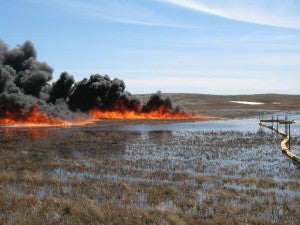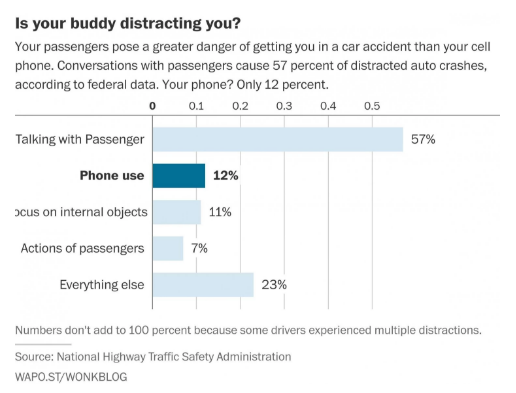By Holly Pearen
When the oil and gas industry spills or leaks harmful fluids – whether toxic oil or chemical-laden wastewater – the damage to local ecosystems can last for decades.

A crude oil spill on a wetland in Mountrail County, North Dakota.
Photo source: US Fish and Wildlife Service
Understanding the most common causes of accidental releases could help stakeholders take corrective measures to avoid them. Unfortunately, many regulators don’t collect and make transparent critical information about how many accidents are happening, and what causes them.
For other risky activities, regulators gather and publish information about the most common causes of negative events. Take national car accident rates, for example, as illustrated in this infographic from the Washington Post.

This specific information about the leading causes of traffic accidents helps drivers pinpoint exactly which behaviors cause problems, and hopefully that awareness prompts behavior modifications.
Data lag
Information about the leading cause of leaks and spills from oil and gas activities isn’t available because many regulators don’t require operators to report the real cause of incidents- instead accepting unhelpfully vague descriptions like “equipment failure” or “human error.” In a recent multi-year research effort, the Environmental Protection Agency looked at approximately 12,000 recorded spills potentially related to oil and gas activity. These spills represented only a “subset” of data from just two states- Colorado and Pennsylvania. National data about spills and information from other states was simply unavailable or of such poor quality as to be useless. Even worse, the spill data that was available didn’t contain enough information to allow for meaningful analysis. EPA was only able to determine that the “cause” of the greatest volume of produced water spills was “failure of container integrity,” which is a lot like saying that the cause of the spill was a spill. Nearly a third of hydraulic fracturing fluid spills had an unknown source.
Spill Data at Work
Fortunately, some states have enacted comprehensive incident reporting rules that are improving oil and gas industry performance. The North Dakota Industrial Commission (NDIC) is an excellent example of a state oil and gas regulator collecting, analyzing and responding to issues identified in comprehensive spill and leak reports. In 2014, the NDIC lowered the spill reporting threshold for crude oi and produced water (brine) to one barrel (42 gallons) for all spills, contained and uncontained. This means that the NDIC now collects detailed information about a lot of spills, and although industry initially complained about this, it’s starting to pay off.
For example, the state found the overall spill rate dropped 27% from 2014 to 2015, which is great. But it also uncovered a less desirable trend; the number of contained spills (spills that occur within enclosed areas surrounded by berms or dykes) dropped from about 80% in 2014 to roughly 70% in 2015. The lower containment rate suggests that the current diking requirements may not be sufficient to contain spills. North Dakota regulators said they used this data to put better environmental protections in place that require 6-inch perimeter berms around new and existing well sites. According to the NDIC, the containment rate would have been closer to 98% if those rules had been in place earlier. This relationship between the circumstances on the ground and evolving, targeted regulations is really terrific.
Ohio is another state that making progress. The Ohio Division of Oil and Gas Resource Management recently proposed new reporting rules that are helpful for making sure that the impacts of spills and leaks from oil and gas operations are mitigated efficiently. Reporting requirements that include brine spills, a single hotline or contact to receive incident reports, standardized information collection expectations, and clearly defined triggering events are all helpful to make spill reporting fast and easy for operators or others managing a stressful incident. To make the proposed rules more helpful, the agency could require reporting of root causes and lower their reporting threshold across the board and add reporting requirements for contained spills.
To reduce oil and gas industry spills across the country, we need more comprehensive reporting rules that require operators to identify the root cause of the leak or spill, accurately characterize the amount and contents of substances released, and describe mitigation measures in detail until the impacts are abated. Only this type of spill reporting will provide the information necessary for meaningful analysis and regulation that reflects the real causes of leaks and spills.
Enviroshop is maintained by dedicated NetSys Interactive Inc. owners & employees who generously contribute their time to maintenance & editing, web design, custom programming, & website hosting for Enviroshop.
